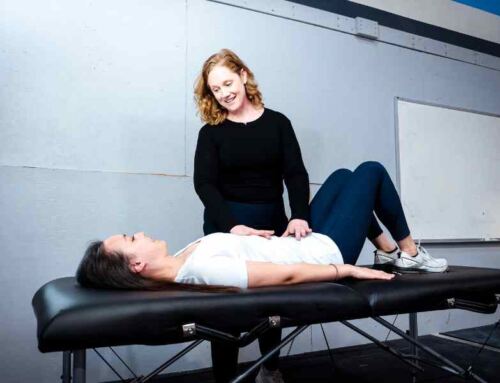A Physical Therapy Guide to Diastasis Rectus Abdominis
It would be redundant to say that the body undergoes some major changes during pregnancy—beyond the heart remodeling, the ribs splaying, and hormones changing, an ever-expanding abdomen can be hard to miss.
While the body makes space for a growing uterus, the stretch across the abdominal wall can create an abdominal separation, also known as a diastasis recti abdominis (DRA).
Although this can sound scary, it’s a very normal part of pregnancy, and getting diagnosed with a DRA doesn’t have to be a prescription for lifelong inactivity. Here’s everything you need to know about pregnancy-related DRA, how to treat it, and how working with a specialized physical therapist can help.
What is a Diastasis Recti Abdominis (DRA)?
A DRA is a temporary problem of coordination, exercise intensity, and pressure management in the abdomen. Simply put, a DRA is a big stretch across the linea alba, the tendon that vertically connects all the abdominal muscles (including the rectus abdominis, the six-pack muscle).
The linea alba runs from the bottom of your sternum bone to the pubic symphysis at the top of the pelvis. During a rapid and sizable expansion of the abdomen, like in pregnancy, the muscle bellies of the six-pack muscle can be pulled farther from each other, creating a ‘gap’.
This ‘gap’ can occur at the belly button, above the belly button, or least commonly, below the belly button. This ‘gap’ can make it more difficult to generate muscular force during exercise or functional activities, like lifting.
What is Considered Normal?
Studies have shown that up to 100% of women may experience a DRA in the third trimester of pregnancy. Whether it resolves postpartum depends on several factors, such as maternal age, tissue health, or pregnancy with multiples (twins or triplets).1
There isn’t a clear consensus on how to measure a DRA, because it can vary by where the measurement is taken in the linea alba. The most generally agreed upon measurement is <3 cm as measured by ultrasound, or about two finger widths.
A physical therapist who specializes in women’s health will also measure the depth of the ‘gap’, measuring tension and efficiency of loading across the fascia. Again, however, there aren’t clear normative values shown in scientific research.

Busting Common Myths About DRA
- Having a big baby or gaining weight will increase my risk of DRA. Not true! There’s no association between pre-pregnancy body mass index, weight gain, a baby’s birth weight4
- Crunches will make my DRA worse. Crunches actually have better evidence than a ‘drawing in’ exercise in reducing the width of a DRA in women who were 36 weeks pregnant and up to 26 weeks postpartum2
- DRA causes back pain. Although DRA may be correlated with lower back pain, having a DRA has not been shown to directly increase your risk of having back pain.
Can I Exercise with a DRA?
The short answer—YES! Exercise has the best evidence for restoring normal tissue tension compared to taping or surgery.4 It seems that the best way to restore normal tension to this area is to load the fascia.
While there is plenty of fear-mongering around ‘bad’ or ‘dangerous’ exercises to do with a DRA (looking at you, crunches), this is more myth than reality. Most exercises can be scaled for your current abilities. If you notice the abdomen forming a triangle shape (called ‘doming’ or ‘coning’), it may indicate it’s time to scale that exercise back for now.
How Can a Physical Therapist Help?
If you’re worried that you may have a DRA, don’t panic. A physical therapist can help in a number of ways, including measuring the width and depth of the gap, applying manual therapy techniques to restore normal fascial mobility, and help design an individualized exercise program to meet your goals.
Whether you’re trying to stay active during pregnancy or are newly postpartum, schedule a session today to start moving!
References
- Fernandes da Mota PG, Pascoal AG, Carita AI, Bø K. Prevalence and risk factors of diastasis recti abdominis from late pregnancy to 6 months postpartum, and relationship with lumbo-pelvic pain. Man Ther. 2015;20(1):200-205. doi:10.1016/j.math.2014.09.002
- Fernandes da Mota PG, Pascoal AG, Carita AI, Bø K.The Immediate Effects on Inter-rectus Distance of Abdominal Crunch and Drawing-in Exercises During Pregnancy and the Postpartum Period. Journal of Orthopaedic & Sports Physical Therapy. 2015;45(10):781-788.
- Benjamin DR, Frawley HC, Shields N, van de Water ATM, Taylor NF. Relationship between diastasis of the rectus abdominis muscle (DRAM) and musculoskeletal dysfunctions, pain and quality of life: A systematic review. Physiotherapy. 2019;105(1):24-34. doi:10.1016/j.physio.2018.07.002
- Michalska A, Rokita W, Wolder D, Pogorzelska J, Kaczmarczyk K. Diastasis recti abdominis — a review of treatment methods. Ginekologia Polska. 2018;89(2):97-101. doi:10.5603/gp.a2018.0016
About the Author
Dr. Molly Morgan is a physical therapist and pelvic health specialist with MovementX in Portland, OR. She believes that it’s imperative to have a strong, functional foundation in the pelvic floor. Molly Morgan is passionate about treating a variety of pelvic floor conditions, lumbosacral dysfunctions, and hip pain. She is committed to providing one on one care to meet you needs and work towards your goals.








